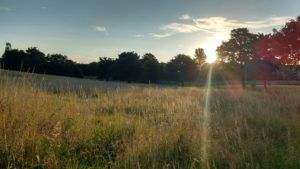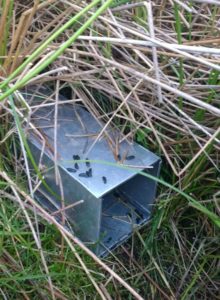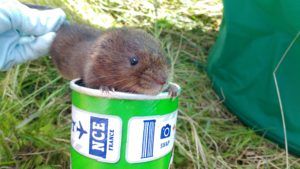Water voles numbers have plummeted by around 90%, one of the most rapid and serious declines of any British wild mammal ever. But an unusual population of city dwelling water voles has given hope for the future for this charismatic animal. In this blog post Robyn Stewart from the Water Voles in the City project delves into the research they are doing to better understand the Glasgow water voles.
Water Voles in the city – Robyn Stewart
 Grassland-dwelling populations of water voles came to light in the city of Glasgow in 2008 and studies have shown that these amazing populations have adapted to living in disturbed urban environments using grasslands like parks, gardens, road verges and even vacant and derelict land. These populations have since been recognized as nationally significant because of their unusual terrestrial behaviour and high population density (over 100 water voles per hectare!). Their existence is a remarkable example of wildlife adapting to living alongside us in an urban environment and has significant implications for future UK conservation efforts as grassland habitat can offer a refuge from American mink. It is likely that grassland-dwelling behaviour may be under-recorded elsewhere in the UK.
Grassland-dwelling populations of water voles came to light in the city of Glasgow in 2008 and studies have shown that these amazing populations have adapted to living in disturbed urban environments using grasslands like parks, gardens, road verges and even vacant and derelict land. These populations have since been recognized as nationally significant because of their unusual terrestrial behaviour and high population density (over 100 water voles per hectare!). Their existence is a remarkable example of wildlife adapting to living alongside us in an urban environment and has significant implications for future UK conservation efforts as grassland habitat can offer a refuge from American mink. It is likely that grassland-dwelling behaviour may be under-recorded elsewhere in the UK.
The Glasgow Water Vole Project was created as a partnership project between the University of Glasgow, Scottish Natural Heritage and Glasgow City Council and worked with numerous stakeholders to map grassland populations across the city, raise awareness and provide training in survey techniques. The partnership project has gone from strength to strength since then by joining forces with the People’s Trust for Endangered Species and the Seven Lochs Project. With this essential support the Glasgow Water Vole Project can now focus on carrying out scientific research in order to investigate some of the many mysteries still surrounding the ecology and behaviour of these incredible populations.
Radio-collaring Ratty
 The first stage of this research is to carry out a radio-tracking study into their home range size. Does home range vary at different population densities, between males and females, or by body size? Grassland populations occupy an area rather than a linear water course and we still do not understand how this influences how they use their habitat or daily activity patterns. The second stage is planned for next year and will focus on the impact of different grassland management techniques at a population level. These grassland populations are already subject to considerable levels of habitat fragmentation in their urban environment and face future development pressures. These findings will go to inform future habitat and population management guidelines and provide guidance for future regeneration and development plans for the city.
The first stage of this research is to carry out a radio-tracking study into their home range size. Does home range vary at different population densities, between males and females, or by body size? Grassland populations occupy an area rather than a linear water course and we still do not understand how this influences how they use their habitat or daily activity patterns. The second stage is planned for next year and will focus on the impact of different grassland management techniques at a population level. These grassland populations are already subject to considerable levels of habitat fragmentation in their urban environment and face future development pressures. These findings will go to inform future habitat and population management guidelines and provide guidance for future regeneration and development plans for the city.
 We started trapping in August at two sites, one with low water vole population density and the other with high population density, and successfully radio-collared five individuals at each site. Amazingly we collared five males and five females which we couldn’t have done if we had tried! The radio-collars are tiny (only 2.9g) and were fitted to adult water voles above 120g because at less than 2.5% of their body weight the collars would not take too much energy to carry around.
We started trapping in August at two sites, one with low water vole population density and the other with high population density, and successfully radio-collared five individuals at each site. Amazingly we collared five males and five females which we couldn’t have done if we had tried! The radio-collars are tiny (only 2.9g) and were fitted to adult water voles above 120g because at less than 2.5% of their body weight the collars would not take too much energy to carry around.
Four weeks in
![]() We were keen to get as much detailed information on their day-to-day movements and activity patterns as possible so we have opted to follow each individual intensively. To do this we conduct 30 minute radio-tracking blocks taking fixes of their position at two minute intervals. These blocks are repeated for every hour of the day from dawn until dusk until we have a complete day of radio-tracking for each individual. Four weeks in and we have an incredible 45 hours of radio-tracking with over 1300 fixes and counting! This scale of detail will enable us to analyse not only home range size but also activity patterns, how quickly an individual might move across their home range, time spent underground and variation between individuals.
We were keen to get as much detailed information on their day-to-day movements and activity patterns as possible so we have opted to follow each individual intensively. To do this we conduct 30 minute radio-tracking blocks taking fixes of their position at two minute intervals. These blocks are repeated for every hour of the day from dawn until dusk until we have a complete day of radio-tracking for each individual. Four weeks in and we have an incredible 45 hours of radio-tracking with over 1300 fixes and counting! This scale of detail will enable us to analyse not only home range size but also activity patterns, how quickly an individual might move across their home range, time spent underground and variation between individuals.
Findings so far
We have done some initial analysis of home range size and already the study is yielding some fascinating insights. The results are all very preliminary but distinct home ranges are starting to become evident between individuals with males having a larger home range which appear to overlap females. We are also finding a marked difference in home range size between the low density and high density sites – home ranges are up to three times the size at the low density site! We are also finding that the water voles are not straying beyond the boundary of their long grass habitat, something which seems intuitive, but could prove important for their future habitat management and the creation of dispersal corridors. We still have a lot more work to do but look forward to updating you all again soon!
